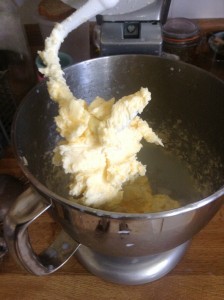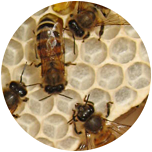 We occasionally get a gallon of fresh cow’s milk from a charming Jersey named Sultana; it is a deliciously heart-breaking reminder of hedonism lost.
We occasionally get a gallon of fresh cow’s milk from a charming Jersey named Sultana; it is a deliciously heart-breaking reminder of hedonism lost.
The milk is not homogenized so the cream floats on top and the consistency of the cream changes from the bottom of the cream cap to the top—I have to break the cap, it is so thick. It is spoonable like sour cream, or even thicker than sour cream. Beneath that is cream as viscous as honey, then the cream you might recognize as whipping cream, then table cream, then cream that is hard to skim because a little milk finds it way into my spoon.
Now, if you are of the finer classes, with access to European groceries, this may be old hat to you. If, however, you were raised on North American Grocery Store Dairy, or like me, by hippiesTechnically my parents were Back to the Landers, not hippies. So they had all the work with none of the free love and little in the way of drugs. But there were naked people. with goats, udder-fresh cow’s milk is quite a revelation.
For a small family, a gallon of milk can be quite a bit to keep up with, so despite the yogourt and cheeseI have found Brie cheese to be very easy to make, but hard to cure and keep. But I personally made the most delicious Brie I have ever tasted. and the richest of cream in my coffee,Did I mention it is rich and creamy? a spoonful of thick cream melts into my coffee, leaving a radiant layer of yellow butterfat globules on the surface—something I have never seen from any white product from a store. we always have enough to make butter.
One big caveat here. Butter is spectacularly easy to make, if you own a kitchen mixer.We got one as a wedding gift. Thanks Ben and Camilla!
Most of my cheese and butter is made with dairy that has been frozen. So, from the gallon we skim off two or three cups of cream.Interesting factoid that is extremely obvious once you think about it—the longer it has been since birthing, the less fat in the milk. ‘Cause the calf is all growed up and eating mostly solid food. So, if it has been a year since the calving, it may get more difficult to make butter from the cream. We portion the milk into quart jars for the week, and freeze whatever is left from the week before, minus whatever was used on cereal or ice cream or baking or whatnot. The cream is scooped into old yogourt tubs for freezing.
My first butter was cultured butter—so the cream had started to become sour cream.A whole foods enthusiast pointed out pasteurized milk is dead, whereas raw milk is alive. So store-bought milk rots, while raw milk ages. In this case, into sour-ish cream. Cultured butter has a bit of tang to it, which, being a fan of yogourt I like. C— prefers sweet cream butter, which I will get to shortly.
So. Allow your cream to come to room temperature, then begin whipping in the mixer. As it thickens I increase the speed until I can crank it up without splashing everywhere. At this point I go do other things, and come running when the foamy sounds of whipping cream turn to distinct splashing. The fat has solidified to butter on the whisk, and the buttermilk is splashing everywhere (use a splash guard and cover all the openings with plastic wrap).
Like I said, spectacularly easy. If you were going to bake a cake, you could probably stop here. But there is still buttermilk trapped in the butter, which will cause the butter to go rancid. So, I drain off the buttermilkIf you are actually making cultured butter, then this is real buttermilk—like you read about in books. It is different from the stuff you buy in the store—tangy, buttery, milky, creamy—I don’t know. The tang is a slight acidity, which is what reacts with baking soda to make buttermilk pancakes rise up so fluffy. and pour in icy water. Beat on a low speed—I often use the dough hook for this, but other people don’t so see what suits you. Drain off and refresh the icy water (I use water with little bits of ice still floating in it, hence the dough hook) and continue gently mixing until the water runs clear.
Now you need to get the last of the water out of the butter. This was traditionally done with two wooden paddles called Scotch Hands, but I use a wooden spatula and mash the butter inside a straight-sided bowl. You will mash little pockets of water that will run down the golden butter like tears. Part way through this process is the time to add salt, at a rate of 1/4 tsp. per each 2-4 cups of cream—in other words, to taste.
I roll the butter up into a log in waxed paper, then refrigerate or freeze it. It is fantastic—decadent and abundant.
Notes on making butter:
- I tend to start with about six cups of cream for each batch.
- Here is an explanation from America’s Test Kitchen if you want to culture cream for butter— preferring that for some reason to my method of just letting everything sit around for a while…
- Making sweet cream butter is exactly the same process, but with fresh cream. Here is an Instructables on that.
- I recently had Whey Butter, which is made from the whey left over from cheesemaking. It is, in fact, kind of cheesy in flavour, and a little tart like cultured butter. Whey Butter does incline one to use a lot of it, smeared on anything that is near to hand. But—when I make cheese I tend to use the whey for ricotta, and I am not sure how much butter you get out of a couple of gallons of whey. This may be something that requires a more industrial scale of whey production—if anybody knows, please comment.

What do you do with the milk that is left once the butter comes together? Do you throw it out or use it in something else?
Hi Helen, thanks for reading.
I would say the priority list goes something like: bake with it, drink it, or feed it to animals.
If you have made sweet butter, from uncultured cream, the buttermilk will be delicious—like milk with little bits of delicious butter floating in it. This is a fine liquid for baking.
If you have made cultured butter, the buttermilk will be tangy—which some people still like to drink. It will also have some acid that will react with baking soda to leaven baked goods.
Hi there, Im planning on using frozen cream to make butter. Will the cream begin to sour while defrosting? I want make sweet butter. How long do you think 1kg of cream will take to defrost and come to room temperature? thanks
Hi there,
The cream certainly could sour, but it probably won’t happen that fast. 1 kg. of cream should defrost overnight in your fridge.
I have had some problems with making butter from frozen cream—sometimes it works, sometimes it doesn’t. This may or may not be related to the cow’s cycle. The milk gets less fatty the further away from birthing, and seem sto eventually be not fatty enough to make butter.
All of which to say, there are a lot of variables. Good luck!
But the last time I was having troubles… The cream whipped for a while, and then just went kind of grainy. It was butter, but it was tiny little balls of butter that wouldn’t stick together. I added a little fresh cream and that was the kick it needed.
Have fun.
Ruben.
[…] this morning I had a slice of fresh whole wheat sourdough bread with homemade butter and Blood Orange marmalade made with oranges we grew ourselves. As breakfasts go, I enjoyed it a […]
[…] How to make butter. […]